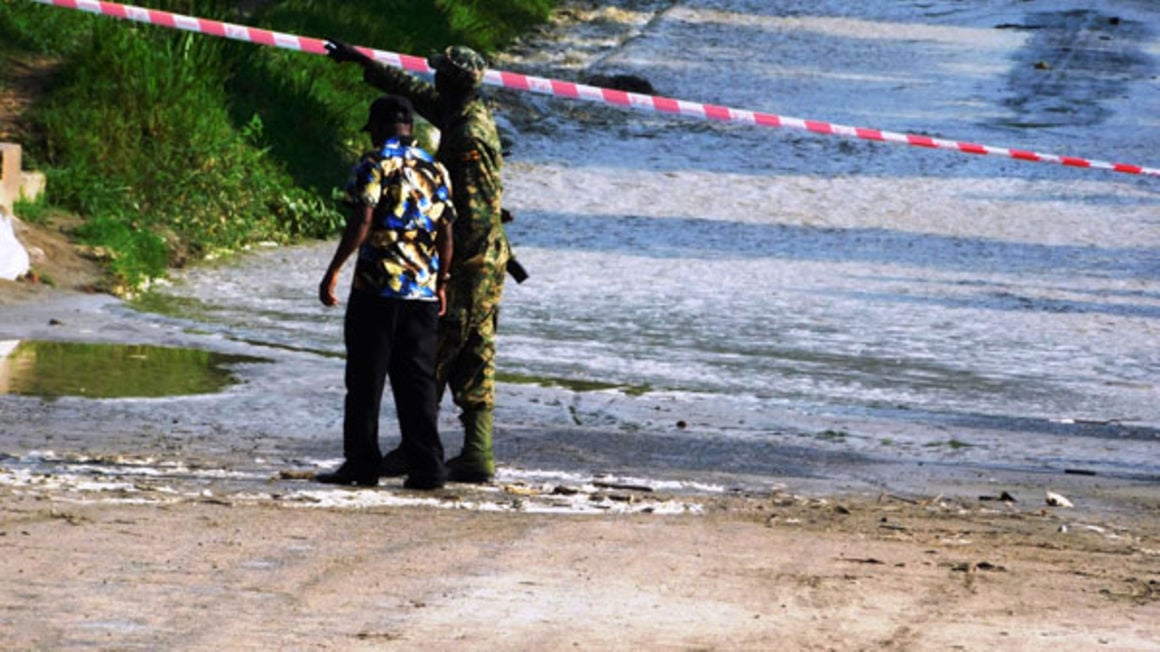Kasese leaders move to save River Nyamwamba

A UPDF officer sealing off the road at Ngagi bridge after river Nyamwamba in Kasese District flooded into the road leaving some travellers stranded on June 28, 2020. PHOTO | FILE
What you need to know:
- Catalysts. The district experiences devastating floods every year, with River Nyamwamba always bursting its banks, leaving a trail of destruction. More than 100,000 people were affected by floods that hit Kasese District last May, destroying gardens, bridges, schools, houses and other properties.
Authorities in Kasese District have embarked on a plan of protecting River Nyamwamba that is increasingly faced with flooding due to encroachment and sand mining.
The plan, which is being implemented in collaboration with the Ministry of Water and Environment, involves planting of bamboo trees on the river banks.
Mr Augustine Kooli, the Kasese District environment officer, said under the Uganda Go Green campaign, the Ministry of Water and Environment procures bamboo seedlings then the district, with the help of non-governmental organisations and the locals, plant the trees.
“Our planting of bamboo trees on the banks of rivers is a sign of re-affirmation, a commitment towards water resource management as water is an economic resource to everybody,” Mr Kooli said during the planting exercise in Kasese on Friday.
He added that while sand being extracted from the river is a threat to the river, they are working to ensure that it is done sustainably.
“We (technocrats) are still struggling to see how sustainable sand mining in River Nyamwamba can be done. We cannot do away with it since it is a major resource in construction,” Mr Kooli explained.
He argued that sustainable mining in other rivers such as Sebwe has been successfully contained.
“Sand miners continue to endanger the river banks, but the government through the environment department has started engaging people doing such activities on the banks to appreciate environmental conservation and protection,” Mr Kooli said.
The district experiences devastating floods every year, with River Nyamwamba always bursting its banks, leaving a trail of destruction.
Mr Samuel Tusiime Tinkasimire from the Directorate of Water and Development in the Ministry of Water and Environment, said bamboo trees have proven to protect the banks better.
Mr Albert Orijabo, an assistant commissioner in the ministry of Water and Environment, said they have embarked on addressing issues of extreme climate impact using an integrated water resource management plan.
“Kasese falls under the Semuliki Management Catchment Area where we as the government are trying to address the livelihood issues that can reduce encroachment on river banks as well as stabilising them,” Mr Orijabo said.
He added that under the draft catchment management plan for River Nyamwamba, stakeholders will be identified with specific roles and environmental issues highlighted.
The team leader for Albertine water management zone, Dr Emmanuel Guma, said they will use lessons from restoring River Mpanga in Kabarole to tame floods in Kasese.
“Planning for a catchment you must first study it, so that is what we are doing for Kasese. We have developed a full stakeholder-driven sub-catchment development plan for Nyamwamba to reduce the impacts of floods on riparian communities (In Ethiopia and Egypt),” he said, adding: “We are also sensitising the communities on sustainable sand mining not to destabilise the rivers.”
The Semuliki catchment area holds many water bodies that all flow to the Nile through Lake Albert.
Kasese Resident District Commissioner, Lt Joe Walusimbi, warned technocrats who issue certificates to people to build in wetlands.




